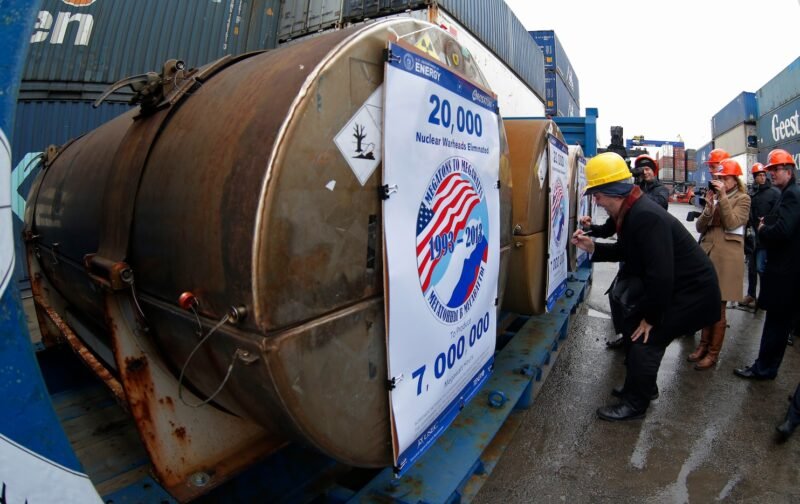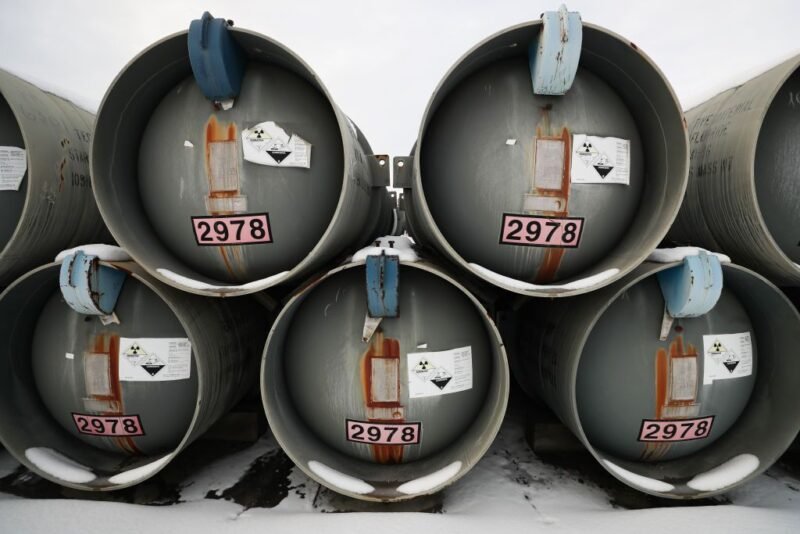Cold War 2.0: Washington & Moscow Race to Develop More Weapons Grade Uranium!

The USSR (and later Russia) and the United States generated more than 200 tonnes of weapons-grade plutonium used in nuclear bombs during the Cold War and nuclear race. One of the most radioactive chemicals on the earth is weapons-grade plutonium. It includes at least 93.5% of the isotope 239Pu, which has a half-life of 24,100 years.
Most of the uranium in current nuclear weapons is approximately 93.5 per cent enriched uranium-235. Nuclear weapons typically contain 93 per cent or more plutonium-239, less than 7 per cent plutonium-240, and minimal quantities of other plutonium isotopes.
Uranium Enrichment
Uranium is primarily made up of two isotopes: U-235 and U-238. Uranium-235, which fuels nuclear reactors and weapons, accounts for less than 1% of natural uranium. Most nuclear applications need to increase the concentration of the Uranium-235 fissile isotope through a process known as enrichment. Gaseous diffusion, electromagnetic separation, aerodynamic processes, laser enrichment, and centrifuge separation are standard enrichment procedures. The industrial method of gas centrifuge production of uranium for military needs and nuclear power turned out to be the most effective.

How does she spin?
The United States and the USSR initially gathered enriched uranium from the gaseous diffusion plants, a method used in the first enrichment plants. The technique used a slow penetration of atoms through a porous partition. This kind of filter allows one to separate one isotope from another – in this case, uranium-235 from uranium-238.
At first, it appeared that the gaseous diffusion process would be easier to adopt even though massive amounts of power were required. Besides the overall high cost and inadequate efficiency, it was unsafe for workers, owing to high temperatures and noise in the stores. Plus, under pressure, enormous amounts of chemically active mixes.
The gas centrifuge separation method does not have such shortcomings and has been known since 1895. The problematic side of the first such uranium enrichment plant was its fragility. And although they initially rotated at a speed of “only” 10 thousand revolutions per minute, it was not easy to cope with the enormous kinetic energy of the rotor. This problem needed at least a 70 mm thick metal cylinder, but the scientists developed alloys to overcome the problem.
Gas Centrifuge Technology has become a hot spot worldwide, including in Iran. Israel and the west are trying to destroy Iranian gas centrifuge facilities.
Nuclear Reprocessing
Natural plutonium instances are scarce. However, it can happen in a process known as spontaneous fission. When uranium ores with a high localised concentration decay under the right conditions, they create minuscule quantities of plutonium. When uranium-238 absorbs a neutron, it produces uranium-239, which eventually decays to plutonium-239 in a regulated nuclear reactor. Plutonium contains at least 15 isotopes. Specific isotopes of plutonium are created by varying isotopes of uranium and different combinations of neutron absorption and radioactive decay.
Because plutonium was found during a war, the vast bulk of plutonium manufacturing was for nuclear weapons. Other uses for plutonium include energy sources for deep space missions and tiny quantities powering heart pacemakers.

Depleted Uranium
The main benefit of munitions with depleted uranium (DU) cores is their penetrating ability. Because DU is a cumbersome element with a density 1.7 times that of lead, its penetrating power is significantly greater than other materials employed for the same purpose.
When a DU-equipped munition comes into contact with a solid object (such as tank armour), it pierces and explodes in a cloud of dust. Very hot particles that form as the DU passes through the armour settle within the tank and ignite the gasoline and ammo.
With its density and physical properties, depleted uranium is a perfect material for use as armour. Because of its high density, DU may be employed as a counterbalance on giant civil aeroplanes, such as the Boeing 747 and in sailboat keels.
DU is a byproduct of uranium enrichment, which is utilised in both weapons and nuclear power. DU munitions were initially employed by the US and British military during the Gulf War.
Only the United Kingdom, France, Russia, and the United States employ DU for military purposes; there is no comparable data on the forces of other nations. Most other countries’ military forces utilise tungsten alloy to attain the same aims. According to the US Department of Defense, DU is the most effective substance for penetration because of its high density and metal characteristics, which allow it to “self-sharpen” as it passes through armour. According to American generals, anti-tank ammunition composed of other materials blunts and flattens.
According to scientists, any alternative to a depleted uranium tip is 20% less effective and 20% more expensive. Although tungsten is not radioactive, its particles are highly toxic.


















